
Applicant Tracking Systems: The Ultimate Guide
Learn what an ATS is and get familiar with the features, benefits, and use cases best suited to improve your hiring.

An interview guide is a document that contains the information and best practices interviewers need to conduct successful hiring interviews. It should cover every part of the interview process, including the questions, rating-specific criteria, and details about the interview workflow. Interview guides are typically developed as part of a structured interview process.
Learn what an interviewing guide looks like, who uses them, why they’re beneficial, and how to build an interview guide. If you want to see an example, we’ve included an interview guide sample at the end to help get you started.
According to Monster, an interview guide saves employers money in the interview process by finding the right candidates faster and easier and improves interview skills by minimizing the amount of decisions that are based on unconscious bias (i.e. gut feelings, first impressions, etc.).
Typically, they are created by the HR or hiring team and provided to interviewers as part of the interview training process.
An interview guide can also be referred to as an interviewing guide, interviewing guidelines, or an interviewer guide.
Interview guides are the roadmap to ensure every interview conducted for a particular position is consistent and focused. It goes beyond outlining the interview questions — it should cover rules and policies, evaluation, and much more. Interview guides also document the process and give interviewers something to stay accountable to.
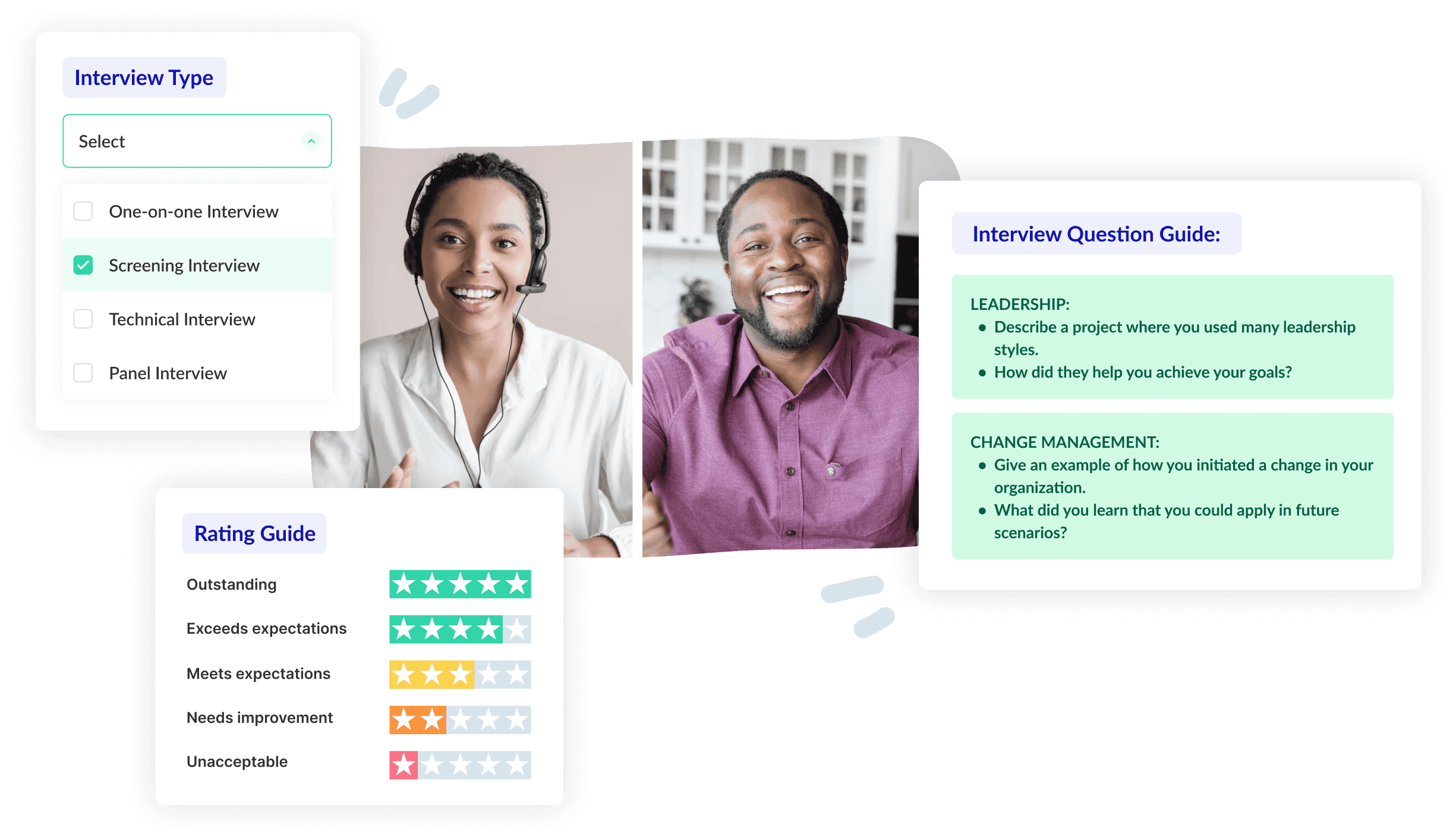
There are multiple benefits to using an interview guide versus a traditional interview approach:
Interview guides help ensure you get consistent results and information from each interview. As every interview for a specific will follow a similar structure and utilize the same set of questions, your post-interview data will also be consistency across candidates.
Interview guides help your organization reduce unconscious biases that the interviewers may have or express when conducting an interview. Doing so will also help companies seeking to increase the demographic diversity of their workforce.
Interview guides typically utilize various tools, such as rubrics and pre-determined questions, that inform better hiring decisions. While there’s no guide to determine how many interviews are enough to make a final decision, interview guides will produce clearer results for each interview and simplify the hiring the decision.
According to Google re:Work, companies can save an average of 40 minutes per interview by implementing a structured interview approach that includes interview guides, rubrics and high-quality questions. This effort saves employers morney in the interview process by finding the right candidates faster and easier and minimizes the occurrence or poor hiring decisions that are based on unconscious bias (i.e., gut feelings, first impressions, etc.).
In a structured interview process, an interview guide is created after the required skills and competencies are identified using a job analysis, the question set is created and evaluated, the rating guide, selection, and assessment criteria are confirmed, and the interview format and workflow are planned. This is because the information from all these components is included in the interview guide.
Every interview guide is unique. The complete interview guide will depend on your organization and position. It can include any or all of the following details:
This list may seem like a lot, but being precise is beneficial when it comes to interview guides. The more information you provide interviewers in writing, the less ambiguity there will be.
How to make interview guides easier to use
Interviewing software can translate your interview guide document into a digital workflow, streamlining your interview guide and making adoption and execution easier for interviewers. Interview guides for asynchronous or live video interviewing software can increase structure and consistency in your process.

The best interview guide would provide a framework for interviewers to conduct effective structured interviews. It should serve as a tool to facilitate productive conversations and help interviewers gather valuable data to make merit-based hiring decisions.
Here are some key elements that make a good interview guide.
Provides clear directions and objectives
Everyone knows what they are doing, what their specific role is, and what the desired outcome of the interview is.
Sets interviewers up to offer a positive candidate experience
It should set the tone about how candidates are to be treated and ensure every candidate is comfortable and has an adequate opportunity to showcase themselves.
Captures legal and ethical considerations
Interviewers should be able to read the guide, know the rules around ethical guidelines, and understand the repercussions if they don’t follow the standardized process.
Makes it easier to conduct structured interviews
An interview guide only works if people use it. If it’s not easy for interviewers to follow, standardization can suffer. This is where digital interview guides can be especially helpful.
How technology can enhance your interview guides
Interview guides should continuously improve with every iteration. Interview intelligence can track your digital interview guides and provide insights related to things like component validity to make them more effective and efficient.
Before you start designing an interview guide, revisit the job requisition to ensure everything you’re doing is aligned. Once you’ve created a guide for a position in a certain department, developing an interview guide for other roles in that department will be easier.
Here’s how to make an interview guide.
In order to put this document together, your team has to do some of the groundwork of planning and organizing a structured interview process. Even if you try to create a draft interview guide, you won’t get far without the information from a job analysis.
This involves:
Working collaboratively with an Industrial and Organizational (I/O) psychologist while you conduct the job analysis can help you identify the key competencies required for the position. I/O psychologists study and assess dynamics in the workplace and apply that research to identify solutions to problems that improve the well-being and performance of organizations and their employees (American Psychological Association).
In addition to creating the interview questions themselves, you’ll also need to anticipate and develop probing and follow-up questions and include them in the interview guide so they can be made available to all candidates in the process.
Need guidance on developing a structured interview process?
All these elements ensure candidates undergo an accurate and identical assessment. After finalizing as many items in the above list as possible, move to the next step.
Interview question types
An interview guide can contain all of one type of interview questions (if it’s a targeted selection interview, for example) or a mixture of different question types. It all depends on your organization’s approach to interviewing. As long as the interview questions have been evaluated and are directly related to the job — it doesn’t matter what type of question you include.

First, review the job description and identify the essential skills, knowledge, and behavioral traits you believe new hires will need to succeed in the role. Collaborate closely with hiring managers and team leads to confirm which competencies they value most from new hires. These will form the foundation of the interview questions in your guide.
Use a dedicated question framework, such as STAR (Situation, Task, Action, Result), if you need to focus on behaviors and results rather than just opinions.
Decide whether the interview will be conducted in person, virtually, asynchronously, or as part of a panel. The format you choose will determine the flow of questions and who asks them.
Consider how the format impacts the way you ask questions. For example, if you’re conducting a panel interview for a senior role, you might want to divide questions by focus areas (leadership, technical skills, cross-functional collaboration, etc.) so that each panelist covers a different competency.
Create high-quality, open-ended questions that directly evaluate the core competencies. Collaborate with team leads to determine what interview questions to ask for each unique job posting. While questions should be specific to the type of job, there are some that may be relevant to multiple roles, or any role within your company.
Examples:
Assign each question to a specific skill, such as problem-solving, communication, or time management. You can use this method to create a more effective scoring system within your rubric.
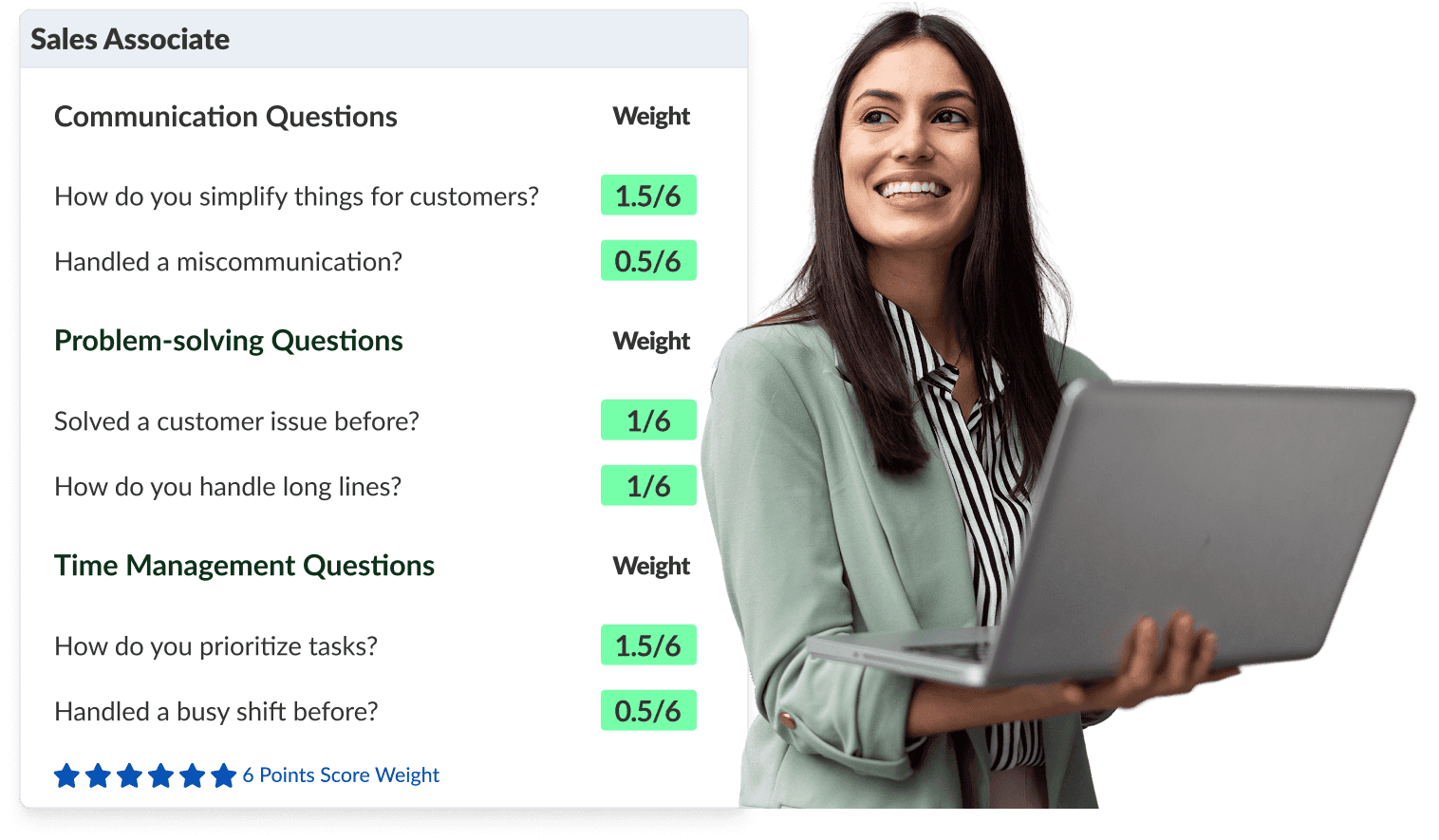
Create a clear and objective rating scale (1 to 5 being the most common) for each question. Provide interviewers using the rubric with sample responses or benchmarks for what “poor,” “average,” and “excellent” answers might look or sound like. This strategy enhances rating consistency and reliability while reducing subjective biases.
Consider using weighted scores if some competencies matter more than others. Some teams or roles may value questions that target hard or technical skills over those that focus on soft skills, for example.
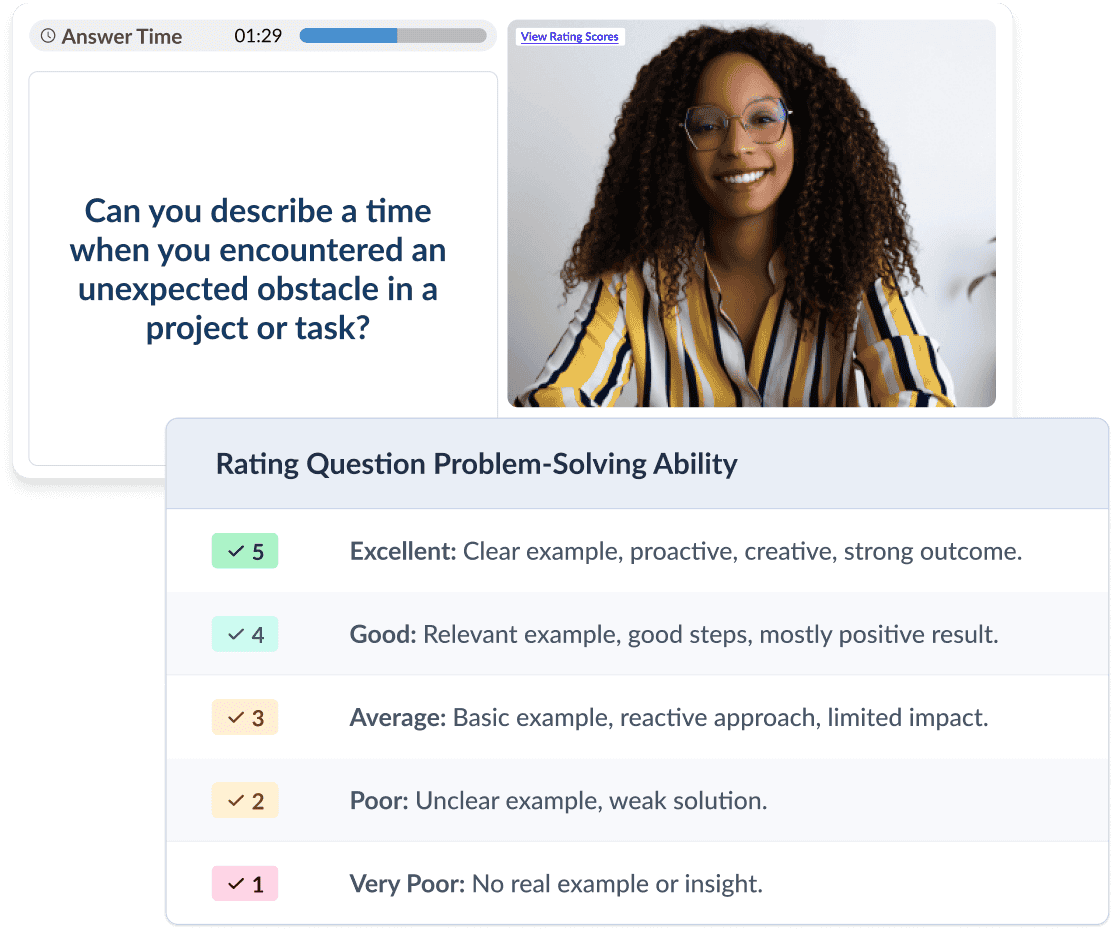
Include a brief but detailed introduction at the top of the guide for interviews that contains the following elements:
Explain the purpose of the interview guide
Note how long the interview should last (give a range, as interview times can vary depending on how interviewees answer questions)
Clarify whether probing or follow-up questions are allowed
Include space for notes and final impressions to help streamline the post-interview debrief.
Put all the elements in the order they will be used. The interview guide introduction should start with the basic information: details related to the job and the interview logistics itself (who, where, when, what to say before and after, etc.). Then include the questions — in the correct order — and the evaluation details. Finally, it’s the interview checklist and any relevant organizational policies.
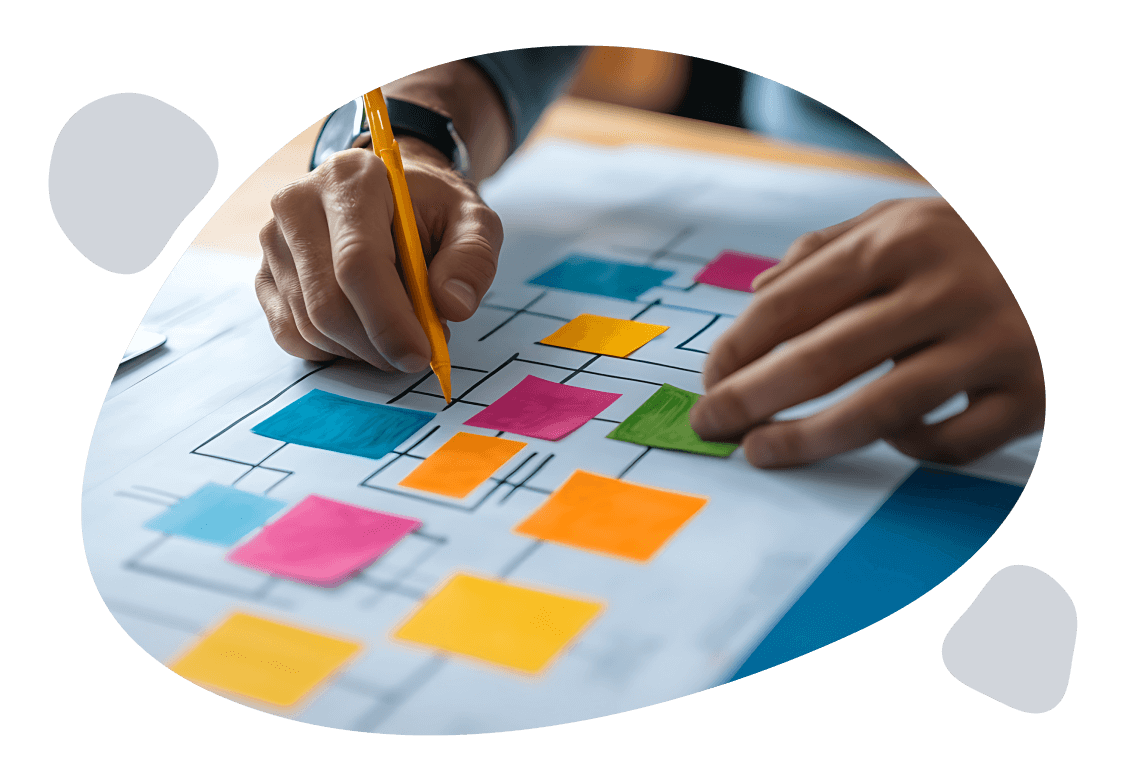
Once the interview guide is complete, before you use it you should have it validated by an I/O psychologist. They will tell you if your interview guide is effective and in line with best practices, and help mitigate the impact of bias in your interviews.
Here’s what I/O psychologists look for in your interview guides.
They can examine whether the questions in your guide effectively measure the qualities or competencies you intend to evaluate. They also provide suggestions on how to improve the reliability of the interview process.
They can review the questions and processes to ensure they are fair and unbiased, taking into account diversity, inclusion and accessibility factors.
With information from your job analysis, they can confirm if the interview questions align with the identified competencies, ensuring that your interview guide effectively assesses the desired qualifications.
I/O psychologists can collaborate with you to edit your evaluation and selection criteria. They will help you confirm if your weighting or scoring methods are appropriate for assessing candidate responses consistently and fairly.
Once their feedback is incorporated, gather your interviewers for training and interview practice. Distribute the interview guide and allow interviewers to go through and ask follow-up questions. Don’t skip this step! Training interviewers on using the interview guide is equally as important as creating the guide.
Often, interviewers will receive a training guide alongside their interview guide. According to Document 360, having training manuals, like interview guides or training guides, can also, “prevents employees from churning, which means you don’t have to bear the cost of hiring lots of new employees and bringing them up to speed.”
What’s a training guide?
A training guide details how to conduct an interview for any position at a specific organization. It can benefit hiring managers who don’t interview often or haven’t hired before. It may include:
Test your interview guide format before standardizing it across your hiring process. Deploy is with a small group of candidates, then collect and review feedback from interviewers about flow, clarity, and effectiveness. Then, iterate the process.
This is not a strict format. Your interview guides should evolve alongside your hiring strategy and vary from position to position. Revisit your guides regularly.
Because structured interview guides are designed to improve your hiring processes, you should see impacts across your organization. Once your interview guide is in use, start tracking how it influences broader hiring and organizational outcomes. Review candidate and interviewer-level data to identify trends, bottlenecks, or inconsistencies.
Key metrics you may want to monitor include:
Example: If candidates who score highly in soft-skill categories like team work capabilities perform well post-hire, you may want to adjust your scoring weights in your interview guide’s rubric to reflect its importance.

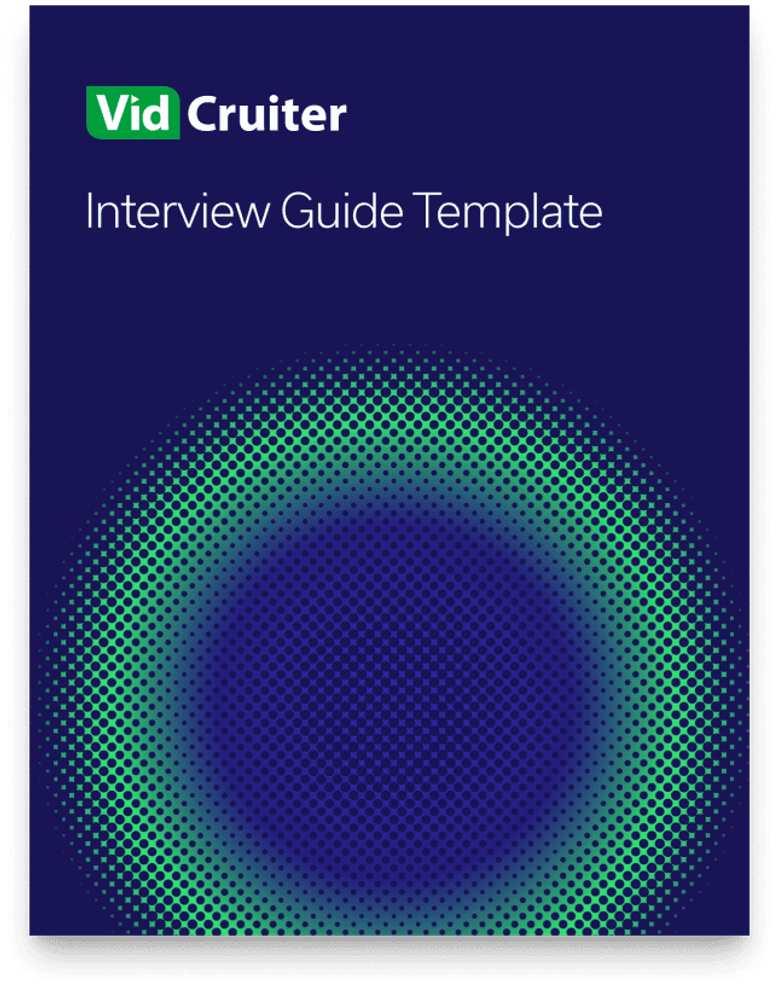
Downloadable Template
Interview Guide Template
Get your free copy of VidCruiter’s Interview Guide Template.
By providing your email address, you agree
to receive updates from VidCruiter.
Read our
Privacy Policy
According to Handshake, a behavioral interview is used to “focus on a candidate’s past experiences to assess how they’ve navigated specific situations and utilized skills relevant to the position.” An interview guide can contain any type of interview questions, but behavioral interview guides only include behavioral interview questions.
Examples of behavioral questions include:
A competency interview guide has many of the same standard components as a typical interview guide. The main difference is that the questions are specifically designed to assess a candidate’s strengths and weaknesses as they pertain to the competencies required by the role.
A competency-based interview specifically includes competency-based interview questions. For example, if you’re hiring for a manager position, you might ask:
Modernize your hiring process with expert insights and advice.